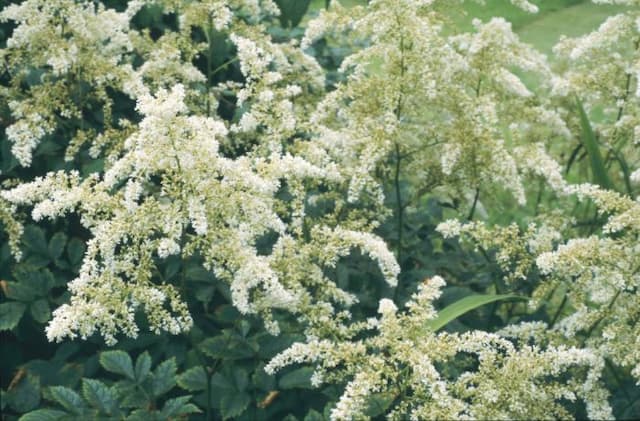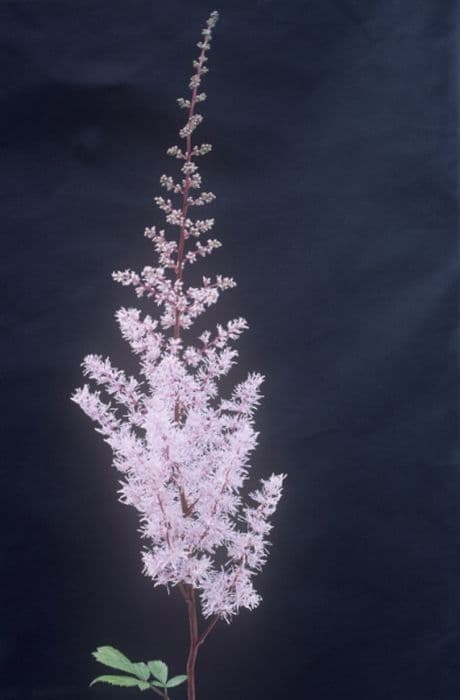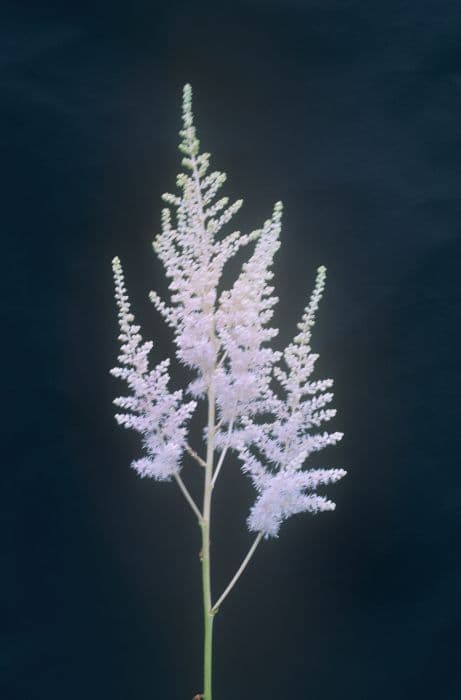Coral Bells Heuchera 'Regina'

ABOUT
Heuchera 'Regina', commonly known as Coral Bells, is a captivating perennial known for its striking foliage and dainty flowers. The leaves of this variety are large and have a rounded, lobed shape, often showcasing a rich tapestry of colors. 'Regina' has a unique leaf color that can be described as a blend of silver and burgundy with darker veins, creating a marbled or frosted appearance. This marbling is more pronounced in the cooler months, adding seasonal interest to the garden. During the bloom period, Coral Bells produce delicate spires of tiny bell-shaped flowers that hover gracefully above the foliage on slender stems. The flowers of 'Regina' tend to be a subtle shade, which might range from creamy white to soft pink. These wispy flower stalks add a light, airy touch to the plant's overall appearance and can provide a contrast to the more substantial presence of the leaves. The plant's form is typically a neat, mounding habit, creating a tidy appearance that suits both borders and container plantings. Whether grown for its exquisite foliage or its charming blooms, Heuchera 'Regina' is valued for the texture and color it brings to landscaping designs.
About this plant
 Names
NamesFamily
Saxifragaceae
Synonyms
Coral Bells, Alumroot
Common names
Heuchera 'Regina'.
 Toxicity
ToxicityTo humans
Coral bells are considered non-toxic to humans and generally do not cause any severe symptoms if ingested. While they are safe when handled and not known to cause poisoning, ingestion of any plant material can sometimes result in mild stomach upset due to the presence of saponins or other plant compounds.
To pets
Coral bells are also considered non-toxic to pets, including cats and dogs. They should not cause any serious symptoms of poisoning if pets ingest them. As with humans, the ingestion of plant material can sometimes cause mild gastrointestinal irritation in some pets, but significant toxicity is not expected.
 Characteristics
CharacteristicsLife cycle
Perennials
Foliage type
Semi-deciduous
Color of leaves
Varies
Flower color
White
Height
1-2 feet (30-60 cm)
Spread
1-2 feet (30-60 cm)
Plant type
Herb
Hardiness zones
4-9
Native area
North America
Benefits
 General Benefits
General Benefits- Attractive Foliage: Heuchera 'Regina' has colorful leaves that provide visual interest in the garden throughout the growing season.
- Low Maintenance: This plant requires minimal care once established, making it suitable for busy gardeners.
- Drought Tolerant: Once established, it can tolerate periods of dryness, reducing the need for frequent watering.
- Pest Resistance: Heuchera 'Regina' is generally resistant to pests, decreasing the need for chemical treatments.
- Shade Tolerance: It can thrive in shaded areas where many other plants may struggle to grow.
- Long-Lasting: It is a perennial, meaning it can last for several years, providing value over time.
- Seasonal Interest: It offers seasonal interest with varying leaf colors and sometimes blooms, depending on the variety.
- Soil Versatility: It can adapt to a range of soil types, as long as the soil is well-drained.
- Attracts Pollinators: While its primary appeal is its foliage, the flowers of Heuchera 'Regina' can attract butterflies and other pollinators.
 Medical Properties
Medical PropertiesThis plant is not used for medical purposes.
 Air-purifying Qualities
Air-purifying QualitiesThis plant is not specifically known for air purifying qualities.
 Other Uses
Other Uses- The Heuchera 'Regina', commonly known as Coral Bells, can be used as a natural dye. The roots and leaves may yield subtle shades of red and green for fabric and wool dyeing.
- In arts and crafts, the textured foliage and vibrant colors of Coral Bells make them ideal for creating pressed flower art or botanical prints.
- Coral Bells can function as a subtle flavoring agent when frozen into ice cubes for decorative and slightly bitter additions to sophisticated cold beverages.
- The leaves can be used to add a hint of green to floral arrangements, wreaths, and garlands for an earthy touch in various decorations.
- As a living mulch, the dense foliage of Coral Bells can help retain soil moisture and suppress weeds in garden beds.
- They can be used as a teaching tool for botany or horticulture students to study plant growth, hybridization, and soil requirements in educational settings.
- Coral Bells can serve as indicators of soil pH, as their leaf color can vary with different pH levels—ideal for gardeners testing soil conditions without a kit.
- Their attractive foliage can be used in culinary presentations; though not a common food source, they can garnish plates and cheese platters with their unique leaves.
- For photographers and artists, the variety of forms and colors found in Coral Bells make them a vivid subject for botanical illustration and photography projects.
- In permaculture design, Coral Bells can provide ground cover and support favorable microclimates for other plant species by moderating soil temperature.
Interesting Facts
 Feng Shui
Feng ShuiThe plant Coral Bells is not used in Feng Shui practice.
 Zodiac Sign Compitability
Zodiac Sign CompitabilityThe plant Coral Bells is not used in astrology practice.
 Plant Symbolism
Plant Symbolism- Persistence and resilience: Heucheras, also known as Coral Bells, are hardy plants that can thrive in various conditions, symbolizing the ability to endure and persist through challenges.
- Beauty in diversity: With their variety of foliage colors, Coral Bells represent the beauty found in diversity and the value of different perspectives and appearances.
- Attraction and magnetism: The bell-shaped flowers of Coral Bells are known to attract hummingbirds and butterflies, symbolizing allure and the capacity to draw in positive attention.
- Balance and harmony: Heucheras are often used in garden design to provide balance with their mounding habit and consistent foliage, representing the importance of harmony in life.
 Water
WaterCoral Bells, commonly known as Heuchera 'Regina', should be watered deeply and consistently, allowing the top inch of soil to dry out between waterings. This might translate to watering about once a week, but frequency should be adjusted based on temperature and humidity conditions. Typically, a slow and thorough watering with approximately one gallon per plant is ideal, ensuring the water reaches the root zone. Overhead watering should be avoided to prevent leaf diseases; instead, water directly at the soil level. During the growing season in spring and summer, keep a closer eye on moisture levels, as the plant may require more frequent watering.
 Light
LightCoral Bells thrive in conditions with partial to full shade, especially in the hot afternoon hours. The best spot for Heuchera 'Regina' is one that receives morning sunlight but is protected from the intense sun in the afternoon. Dappled sunlight under the canopy of trees or on the east side of buildings where they get some morning sun is ideal.
 Temperature
TemperatureThe Coral Bells plant is hardy and can tolerate a temperature range from about 30 to 80 degrees Fahrenheit, but the ideal growing temperatures are between 60 to 70 degrees Fahrenheit. It can survive light frosts down to about -25 degrees Fahrenheit, making it versatile across many climates.
 Pruning
PruningCoral Bells should be pruned to remove any dead or damaged leaves and to promote healthy growth and air circulation. Typically, pruning can be done in early spring to tidy up the plant and again after flowering to encourage a neat appearance. The best time to prune is when new growth begins to emerge, as this makes it easier to see what should be removed.
 Cleaning
CleaningAs needed
 Soil
SoilCoral Bells (Heuchera 'Regina') thrive in a soil mix that is well-draining and rich in organic matter. Aim for a pH range of 6.0 to 7.0. A mix of two parts peat moss or coco coir, one part perlite or pumice, and one part compost or well-rotted manure can be ideal.
 Repotting
RepottingCoral Bells do not need frequent repotting and it's typically done every 3-4 years. Over time, they may become woody at the base and can be lifted and divided.
 Humidity & Misting
Humidity & MistingCoral Bells prefer moderate humidity levels but are adaptable to various conditions. Avoid overly dry air, which may cause leaf desiccation.
 Suitable locations
Suitable locationsIndoor
Place Coral Bells in a bright spot away from direct sun.
Outdoor
Plant Coral Bells in partial shade and well-draining soil.
Hardiness zone
4-9 USDA
 Life cycle
Life cycleThe life cycle of Heuchera 'Regina', commonly known as Coral Bells, begins with seed germination, typically in spring, under the right conditions of moisture and temperature. Following germination, the seedlings develop into juvenile plants, establishing a rosette of leaves close to the ground. As the plants mature, they enter the vegetative stage, producing more leaves and expanding their root systems. Coral Bells then enter the flowering stage, usually in late spring or early summer, producing tall, slender stalks with bell-shaped flowers, which can attract pollinators and may result in seed production if properly fertilized. After flowering, the plant may go into a period of dormancy, especially in colder climates, where it conserves energy during the fall and winter. With the return of favorable conditions, Heuchera 'Regina' resumes growth, continuing its perennial cycle.
 Propogation
PropogationPropogation time
Spring to Summer
Heuchera 'Regina', commonly known as Coral Bells, can be propagated most commonly by division. This is best done in the spring as new growth begins, which allows the plant to recover and establish itself during the growing season. To propagate by division, carefully dig up the plant, ensuring you have a good amount of the root system. You can then gently separate the plant into smaller sections, making sure each division has several shoots and a portion of the root system attached. These divisions can then be replanted at the same depth they were growing at originally, spaced about a foot apart to allow room for growth. Water the new divisions well to help establish them. This method is efficient and maintains the characteristics of the parent plant.









